|
POLICE AND THIEVES
Location: the street
With new DS releases
drying up to a mere 40 or 50 a week, this year Iíve mostly been
playing Scotland Yard, because I'm the classic example of an only
child.
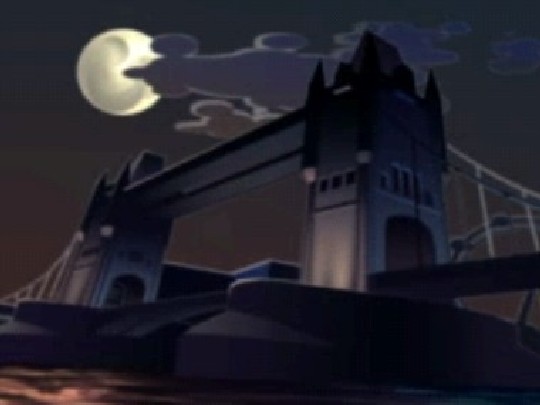
Mr. X is going to have a job stealing this.
Boardgames are brilliant fun, offering
gameplay thatís been tried and tested over years or often decades,
but are usually handled terribly on consoles. Seeking some
justification for running on powerful electric machinery and costing
twice as much as buying the physical version from a toyshop, they
frequently swamp the gameplay in pointless bells, whistles and
cutscenes (which the player is forced to instantly turn off in the
options so that a single game of Monopoly doesnít last for 14
hours), as well as imposing an unwavering
rigidity of rules.
Worse still, some are
so mean-minded and grasping that they make the economics of
using the console to play them simply too farcical to bear Ė hello
DS Scrabble, which eschews the eminently sensible and obvious
possibility of multiple players passing round a single machine in
favour of insisting that all players have their own individual DSes
and copies of the game, raising the price of a four-player game of
Scrabble from about a tenner for a real-life set to somewhere more
in the region of £500. As a result of all the above, boardgame
conversions rarely get reviewed anywhere, which is a bit of a shame
as sometimes it means you might easily miss out on an absolute gem,
and such is the case with Scotland Yard on the DS.
(Missing this
particular gem is even more likely than usual, because at the time of writing
it
seems, rather oddly, to have had a European release but not a UK or US
one.)
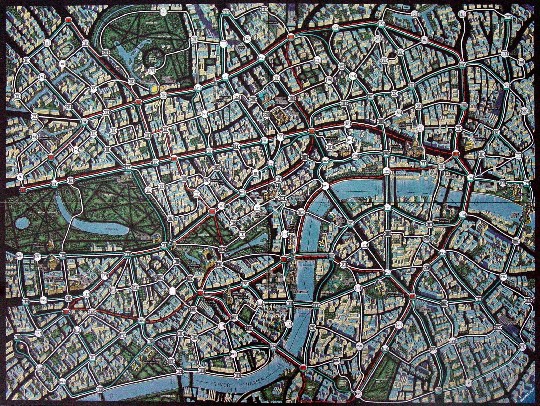
This is an original London boardgame board.
Click the image for a full-size version.
The original board
version is around 25 years old and has sold over 4 million copies
worldwide yet
isnít terribly well-known outside of serious boardgaming circles.
Itís a game of asymmetric warfare, in which one player (a Pink
Panther-style thief called Mr X) has to move around a real-life city
evading a team of detectives (numbering anywhere between two and
five), while the detectives attempt to track his movements using
only details of what forms of transport heís using and occasional
scheduled sightings. (Mr X is a very sporting crook, and rather
kindly agrees to have his last location revealed to his pursuers every five turns or
so.)
WoS isn't about to read the entire
instruction manual to you Ė go and look on the
internet for more info
on Scotland Yard itself if you need it Ė but itís a cleverly-designed, highly entertaining
game (which explains the
quarter-century lifespan and counting) with lots of balance and
flexibility and no reliance on dice or chance except the random
positioning of the characters at the start. It is, however, a bit of
a pain to play in real life due to the preponderance of fiddly
tickets and the difficulty of Mr Xís location having to be
physically concealed. Itís exactly the sort of game, in other words,
that someone ought to port to a console.
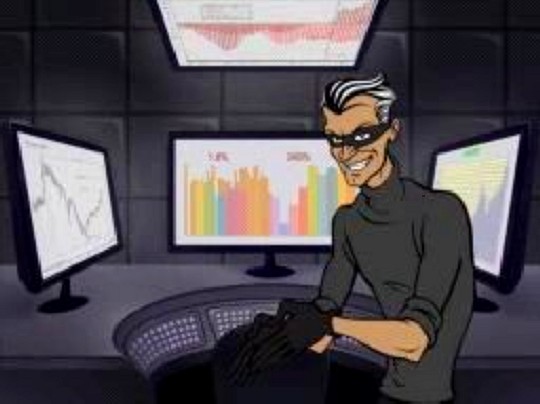
This dude, perhaps. Wait, no, he's much too
thin to be a videogame developer.
The DS version of
Scotland Yard ought to be nailed into the brain of anyone ever
considering bringing a boardgame to a games machine, because itís a
textbook example of how to do it right. For a start you get a lot
more in the box Ė where DS Scrabble stingily just gave you the
vanilla version, with no Super Scrabble or Scrabble Junior, and
makes you sweat blood just to unlock some different board graphics,
Scotland Yard generously offers five different cities Ė two from
real versions of the boardgame and three new exclusive ones, each
map having its own idiosyncrasies. (You start off with only London,
but can unlock New York, Amsterdam, Berlin and Paris by beating the
previous city at any difficulty level, which is extremely easy. You
can even enjoy a full replay of your game afterwards to revel in how
you did it.)
Itís also extremely
flexible. You can play as Mr X or the detectives, at three skill
levels and with any combination of rule variations. You can have any
number of CPU assistants you like - you could, for example, choose
to play as the detectives with two of them controlled by you and two
of them by the CPU. And crucially, unlike DS Scrabble (though
apparently the 2009 edition of Scrabble will put this
right, incremental-update fans), you can
play in ďhotseatĒ multiplayer, using just a single console and
handing it to the appropriate player when required. Lovely.
(Thereís also local
wireless multiplayer, with only London available if youíre playing
against someone who doesnít have their own copy of the game - which
seems pointless because since youíre probably in the same room you
could just play hotseat instead and get all the cities that way, but
itís thoughtful to include it all the same. The same could be said
for the short and skippable cutscenes at the start and end of a game
and the occasional one-line onscreen interjections from Mr X and the
detectives, which add a little extra splash of personality to
proceedings without ever
slowing down the gameplay.)
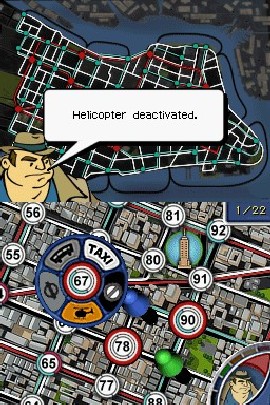
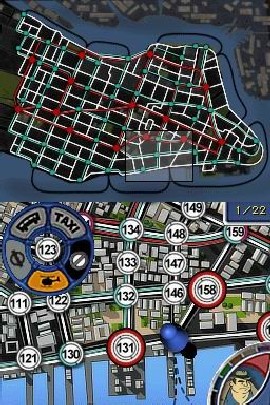
These shots depict the New York map, on default
settings the most difficult location.
On its own Scotland
Yard would already be a brilliant conversion, with a superbly slick
interface and game rules included for newcomers, but the extra
stroke of genius in the DS release is that you also get Campaign
mode, in which you can play any city at one of three difficulty
levels with fixed rules. (You get three save slots, so you can have
one Mr X campaign, one Detectives campaign and a spare slot for a
friend.) In Campaign mode you donít just win or lose, but score
points depending on how well you played (eg capturing Mr X in fewer
moves), and the game saves high scores for
each city at each difficulty level, extending replay value more or
less to infinity - it'll be a long time before you can't improve
your New York (Hard) score.
Simply making Scotland Yard available to play by yourself, or with
friends without all the tedious mucking around with little bits of
card, would have been an honourable feat, especially when done
without requiring multiple DSes. But the developers have really gone
the extra mile here (in fact several thousand extra miles, all the
way from New York to Berlin) and come up with a
brilliantly-transferred and greatly-enhanced game that's made all of
WoS' train journeys in recent months pass by in a blink, as well as
providing countless engrossing hours of home-based sleuthing. You can
really feel the love when you play it, and as a
documented fan of the forces of law and order, WoS recommends it
with all possible vigour and warmth.
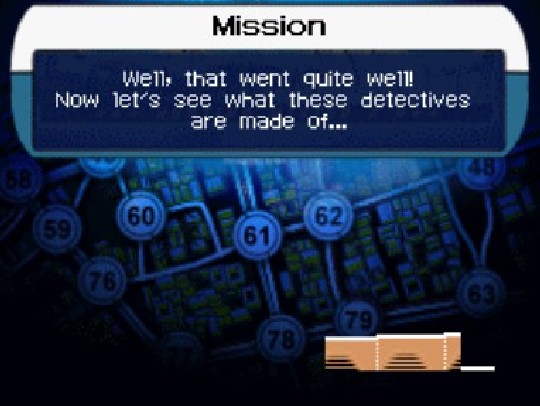
Truncheons, metal staircases and puppy dogs'
tails, perhaps.
But as alert
viewers will know, WoS isn't one for leaving a good seam of
potential gaming unmined. The all-round splendidness of Scotland
Yard DS immediately seized your reporter with curiosity as to
whether anyone had, perhaps in an equally low-profile manner,
thought to bring this excellent game to electronic formats before.
And sure enough, as stealthily as Mr X himself, Scotland Yard has
stalked unsuspecting gamers from the shadows for many years.
The most recent
attempt at capturing its appeal came in the shape of a Windows
version from French publishers Cryo in 1998, slap-bang in the middle
of a period in which the games industry was going mad
for taking classic boardgames like Risk and Cluedo and drowning them
in frippery, cutscenes, new modes and gameplay elements until they
reached a point where they bore almost no resemblance to the
originals whose names they'd appropriated. And so it was with Scotland Yard, which - despite being
described by the reliably hilarious MobyGames as "a faithful PC
version of the 'popular' board game" - found itself relocated to the Victorian era and forcibly
cross-bred with the legends of Jack The Ripper and, less plausibly,
Dracula.
(Quite why MobyGames
felt the need to put quotes around 'popular' is anyone's guess,
incidentally. At over 4m copies, Scotland Yard has sold far more than
99% of videogames.)
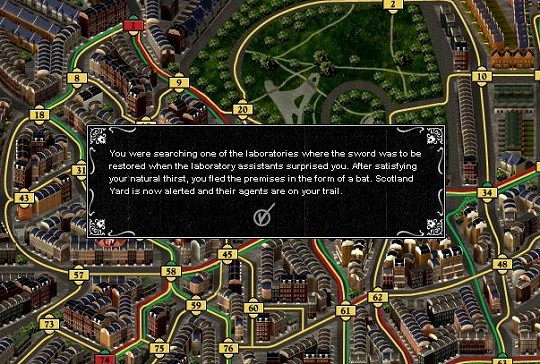
The words "in the form of a bat" ought to have
no place in Scotland Yard.
It took WoS a
considerable amount of time to track down an
abandonware
copy of Scotland Yard For Windows - commercial ones for legitimate
sale were completely impossible to find, although SYFW is the only
version of the game to have ever been officially released in this
country. It took
considerably longer still to install it, thanks to some horrible
online code that required multiple reboots and all manner of
extremely confusing twatting around before the game would consent to
run at all, even though I had no desire to ever utilise the online component
and repeatedly but fruitlessly swore at the PC to that effect.
When it was finally
satisfied that it had enough completely redundant net-software
plugins, it turned out not to be worth all the bother - the "classic" mode had an interface that made the
simplest moves a complete chore, and the enhanced version introduced so much
dizzying complexity to what was once a simple game of strategic
choices that I gave up playing after
approximately a quarter as much time as I'd spent installing it.
That can't be right, can it?
(In the new mode you're
not so much playing a boardgame as a traditional computer adventure
game with isometric graphics. There are suspects to interrogate,
laboratories to investigate, strange characters to meet and items to collect, but mostly there's
just a lot of agonisingly slow trudging around the 3D
sections. Combined with the new setting it's hard to imagine how you
could start out with the same basic premise and then end up with a
game that was very much less like the original Scotland Yard
boardgame than this is. )
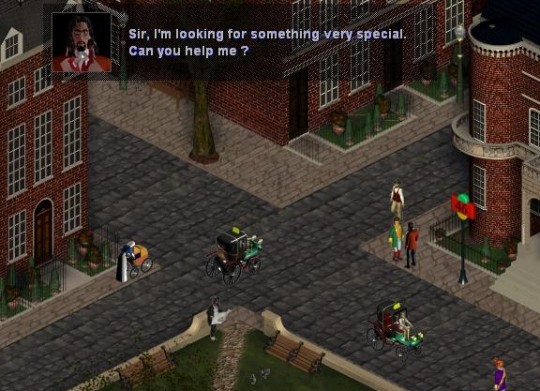
You're right out of luck, mate.
The experimental WoS Time Radar (patent
pending, all rights reserved, wealthy backers sought) next picked up
a signal from 1993. On detailed analysis it
turned out to be from a most unlikely source - namely, the Philips CD-i. The
ill-fated console did most successfully (or more accurately put,
did slightly less disastrously) in Europe, which is coincidentally where
Scotland Yard is most popular, so it's perhaps not a surprise that
the CD-i was the host of the game's only home console port.
Indeed, so niche was its appeal that Scotland Yard Interactive (to
give it its full title) is conducted entirely in German, with no
other language options available.
Much more traditional
in approach than the Cryo game, SY Interactive (interactive as
opposed to what? A slideshow of watching the game play itself?) nevertheless has a few interesting quirks of its
own. Developers in 1993 were still dazed by the awesome storage
capacity of CDs and the vast graphical leap offered by the first
generation of disc-based consoles over the likes of the SNES and
Mega Drive, so the game is full of digitised photographs of London,
apparently taken in a hurry by an unhappy Philips employee handed a compact camera and
sent out in his lunchbreak with a two-zone travelcard. They're not
just for decoration, though - as far as I can tell (all the
instructions are in German, remember), the pictures shown after most
of Mr X's moves show you, with varying degrees
of helpfulness, the actual location of the fugitive.
(WoS unequivocally and unreservedly
condemns the racist comments depicted at the above link, and
apologises to any of its sensitive viewers who may be offended. If WoS
still has
any sensitive viewers left, that is.)
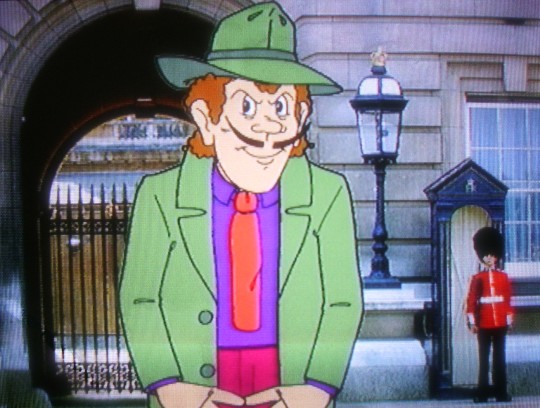
Apparently, Germans think this is
an inconspicuous look for criminals on the run in Britain.
More
often than not, in fact, it'll be the location of the fugitive
robot. Cutely, all the CPU characters in SYI are played by
androids, which the game reports scrupulously at the
end, and in one-player mode you'll always
be hunting down Robi X, rather than the
human version.
If you already know the
rules, beyond the menus the
game itself is entirely playable without requiring any knowledge of
German ("Neuer Fall" starts a new game) and it's pretty nicely done,
if a touch slow-moving. (Mechanically it actually works very similarly to
the DS game.) The best feature, though, is that it comes with two
modes - "Classic" and "London Special".
As far as WoS has been able to
ascertain, the only gameplay difference between the two is that in
"London Special" mode, the reliability of the public transport
systems Scotland Yard is built
around is portrayed in a somewhat satirical manner. Around one in every
seven or eight player moves will fall victim to
buses being out of
service, taxis being broken down, on
strike (below) or on dinner break, or even tube
stations being closed. This, WoS can only
assume, is the German sense of humour at play. Man, you've got to
love those
crazy Teutonic funsters!
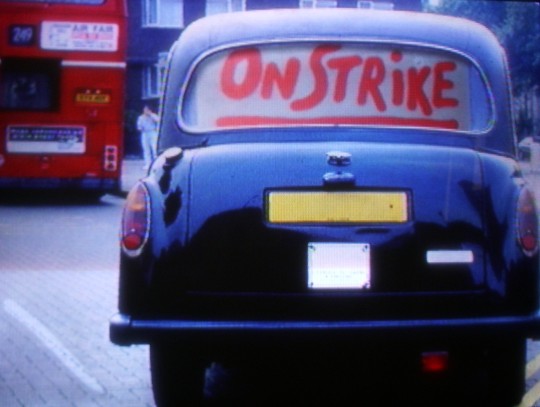
Have taxis ever gone on strike?
If not, nice Photoshopping.
But wait! What's that
insistent beeping noise? Can it possibly be the WoS Time Radar
again? Hold on tight, viewers! We're going back further than we've
ever gone before!
Well, to 1990, anyway,
because as far as WoS's top team of trained and toughened time
technicians have been able to probe, 1990 was the date that heralded the first
ever home electronic-gaming version of Scotland Yard, and it
appeared in an unlikely place. A prophet apparently without honour in the land
where it's set, the game first found a digital welcome in the lands of the
Orient. For it was on the original mono Game Boy, of all things,
that boardgame lovers saw the debut domestic appearance of a Scotland
Yard videogame.
Blimey, it's 20 years
since the mono Game Boy. Yikes.
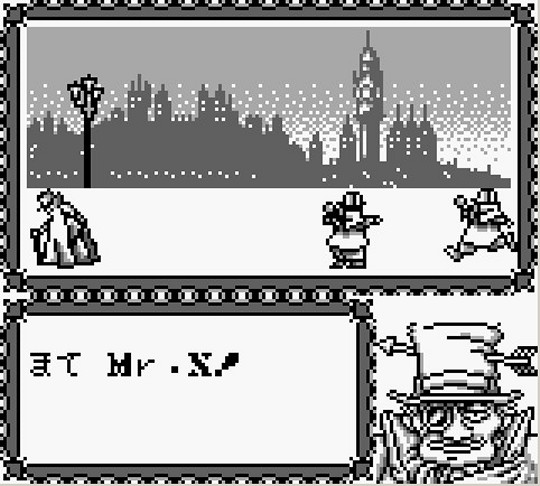
The elusive Mr. X - he really is a master of
disguise.
The GB's little blurry
low-res screen, of course, was never capable of much in the way of
fine detail, so perceptive readers might at this point be wondering
how on Earth it could ever be expected to cope with the lovely
artwork and intricate maps of the board game. And obviously it
couldn't, so developers Toei were forced to think creatively
when it came to recreating the game experience.
The result was something that to a passer-by wouldn't have looked
the least bit like Scotland Yard, and which takes some radical
liberties, but ends up capturing at least the primitive essence of
its character, while adding a flavour all of its own.
The differences between
the Game Boy version and the original, and indeed any of the other
translations, are many and substantial. For a start you can only play as
the detectives, not Mr X. Secondly, the detectives always number
three (usually, as alert viewers will recall from the DS part of the
feature, you can select any number between two and five agents,
which effectively serves as a simple difficulty-setting mechanism).
There are numerous
other significant changes, both to the gameplay mechanics and the
interface. You
can't scroll the map while playing, which itself is a major
alteration. There are no buses or taxis in
the GB game -
movement is by walking or by train, or occasionally by travelator.
There are shops where the agents can sell unused travel tickets to
buy other kinds of ticket or even special sorts of tiles which can
be laid on the ground to restrict Mr X's movements. And the player
gets to nominate one of his detectives to move with a police-dog
unit, which can be used once to search a 3x3 grid of squares around
the detective's location.
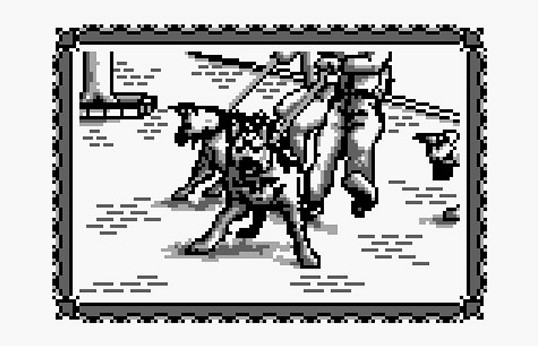
He could actually be one of these dogs for all
we know.
Squares? Well, rather
than the twisted and tangled streets of the original, GB Scotland
Yard depicts its five cities (nominally New York, Paris, Tokyo,
Cairo and London) as simple grids of uniform blocks. You can only move in
the four compass directions and you can't cross railway tracks, so in
the screenshot below the train station located just below and right of
centre can only be exited to
the south and the east, not to the north-west.
With grids comparable
in size to those in the boardgame, that would make tracking Mr X
down with only three agents a fearsomely difficult task, except for
the fact that he can't cross the railway tracks either, and the
detectives' main method of success is to trap him in a cul-de-sac of
train lines with no accessible stations for the fiendish mastermind to escape through.
Balancing this, however, is the
strangest facet of the game, namely Mr X's one-time teleport
capability. Randomly - but usually when you've got him backed into a corner
and one move from capture - he simply vanishes into a magical castle that
wasn't there the moment before (there's one pictured below, in the
centre of the screenshot), which seems to contain a handy sewer
leading to his original start position. See, I told you they were
pretty radical liberties.
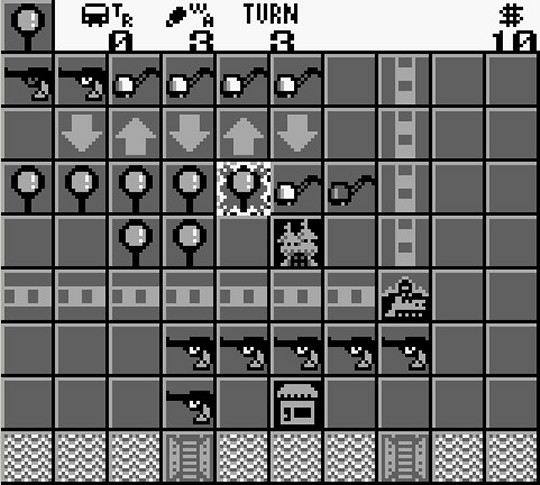
Your agents are represented by the cute
detective-themed symbols. That's the shop at the bottom.
The last weird thing
about the game is that for no good reason, your agents leave a trail
indicating their movements. Now, that wouldn't be weird at all,
except for the fact that there's no visible way of distinguishing
your agent's current position from the trail markers. If you start
doubling back over squares that you've visited before, it becomes
impossible for Agent Briar Pipe to tell (except from memory) which
square Agent Magnifying Glass is actually standing on, making it
tricky to co-ordinate their positions and leaving Mr X the
possibility of dashing through an indiscernible gap between them to freedom. Man!
Given all this, it's
remarkable that the GB version still, after a fashion, feels like
Scotland Yard. But somehow it does, because the core gameplay is
still the same - it's still about forward planning, informed
guesswork and judicious use of limited resources, and once you've
adjusted it's still challenging and fun. It takes some getting used
to if you've played any other version, and by the time you get a
grip on it you'll have learned to fervently hate
the person who forgot to include a music-off option, but it's a
piece of work that makes you want to take your hat off in admiration
to the coders who squeezed it all into a tiny 128K cart, and
to marvel at the strength of a fundamental game design that can
survive being so mangled in the process.
If you want to play
Scotland Yard (and you do), you should unquestionably do it on the
DS. But you really ought to take a moment to pay your respects to
its grandpa too.
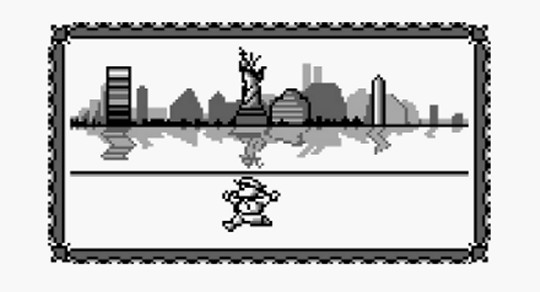
This feature is over. I'm outta here!
The DS element of this piece originally
appeared on Snappy Gamer.
|

